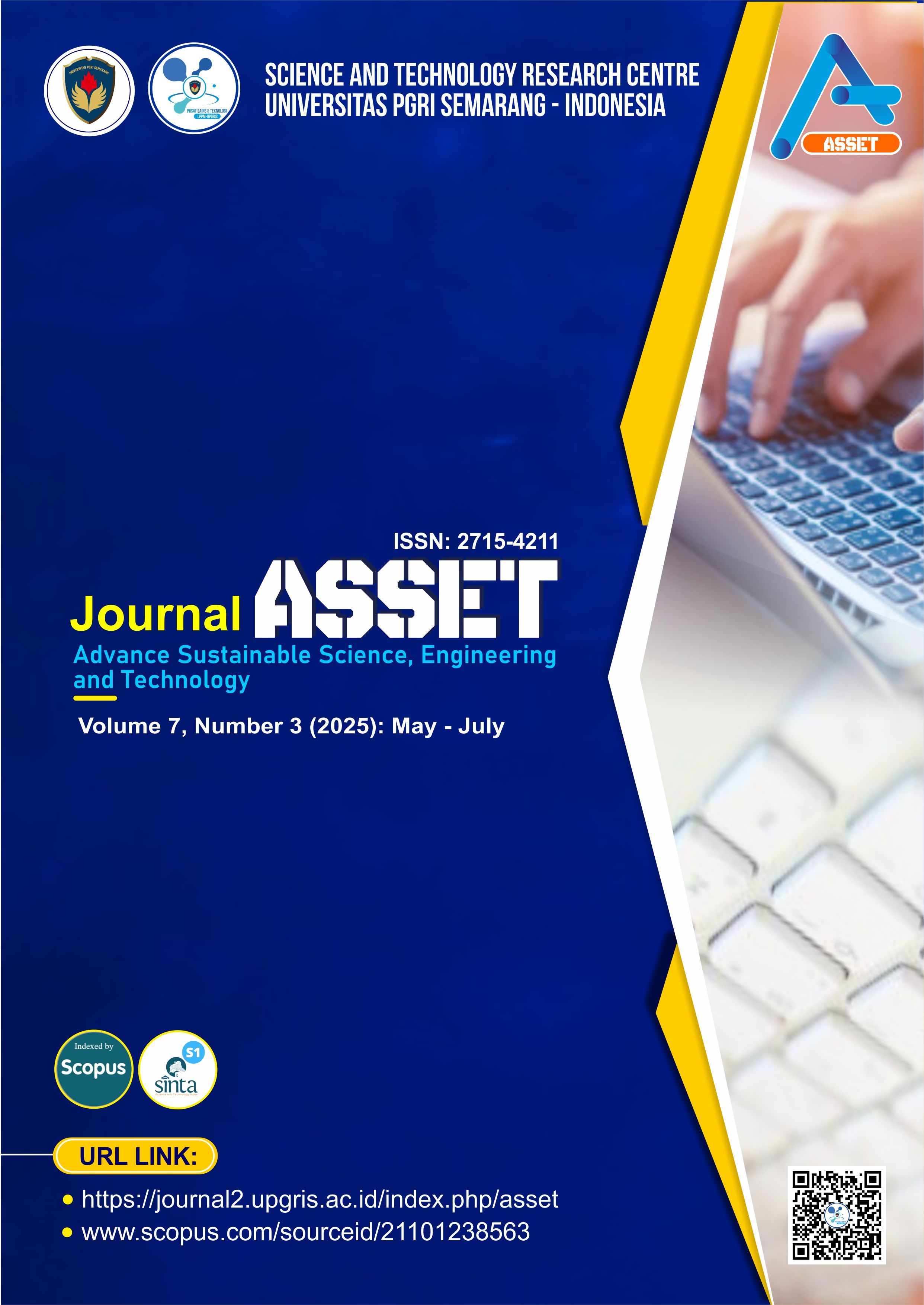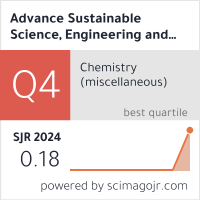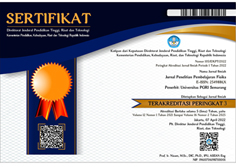Biosorption of Chromiun in Batik Wastewater Using SCOBY Microbial Biomass: A Sustainable Bioremediation Approach
DOI:
https://doi.org/10.26877/asset.v7i3.2199Keywords:
batik wastewater, bioremediation, heavy metals, kombuchaAbstract
Batik wastewater poses an environmental threat due to hazardous heavy metals like lead, cadmium, and chromium (Cr). This study investigated the effectiveness of SCOBY (Symbiotic Culture of Bacteria and Yeast), a microbial consortium from kombucha production, in reducing Cr levels in batik wastewater. SCOBY is a promising biosorbent for heavy metals. The research aimed to assess SCOBY's ability to decrease Cr contamination in different types of batik wastewater (hand-drawn, stamped, and printed) over varying incubation times. Using a quasi-experimental approach, wastewater samples were collected from small and medium industries in Pekalongan City. Results showed that SCOBY effectively reduced Cr levels across all batik wastewater types and incubation periods. The most significant reduction occurred at 3 hours of incubation. Specifically, Cr levels decreased by 53% in hand-drawn batik wastewater, 44% in stamped batik wastewater, and an impressive 71% in printed batik wastewater. These findings suggest that SCOBY treatment is a viable and effective alternative for managing batik wastewater.
References
[1] Novita M, Dewanto FM, Harjanta AT, Herlambang BA, Marlina D, Purwaningsih D, et al. Handmade batik with tuberose motifs as creative home industry idea. Community Empowerment. 2023;8:1168–76.
[2] Soeprapto EF, Cahyadi D, Atmodjo RD. A training on cold wax batik in Bakungan Village, Kutai Kartanegara Regency. Community Empowerment. 2021;6:1908–14.
[3] Pramugani A, Soda S, Argo TA. Current situation of batik wastewater treatment in Pekalongan City, Indonesia. J Japan Soc Civil Eng. 2020;8:188–93.
[4] Lestari S, Dewi RS, Wibowo ES, Atang. Modified Tea Bag Biosorbent as Cr (VI) Removal in Batik Wastewater. IOP Conf Ser Earth Environ Sci. 2020;593:012030.
[5] Sayekti SAP, Nugrohowati N, Lestari W. Faktor - Faktor yang Berhubungan dengan Skoring Tuberkulosis Paru Anak di Daerah Lokus Stunting Wilayah Kerja Puskesmas Kecamatan Tanara Tahun 2019. Seminar Nasional Riset Kedokteran (SENSORIK). 2020;1:135–46.
[6] Lestari S, Oedjijono O, Santoso S, Kusharyati DF, Fathurrohim RH. Bioremediation of Cadmium (Cd) in Batik Wastewater Using Different Carrier Media Containing Rhizobacteria. Biosaintifika. 2023;15:67–74.
[7] Ragil AW, Saifudin AG, Gunawan A, Novaria D. Analisis Strategi Pengelolaan Air Limbah Industri Batik Yang Berkelanjutan Di Kota Pekalongan. Jurnal Sahmiyya. 2023;2:6.
[8] Mousavi SM, Hashemi SA, Amani AM, Esmaeili H, Ghasemi Y, Babapoor A, et al. Pb(II) removal from synthetic wastewater using Kombucha Scoby and graphene oxide/Fe3O4. Phys Chem Res. 2018;6:759–71.
[9] Mousavi SM, Hashemi SA, Babapoor A, Savardashtaki A, Esmaeili H, Rahnema Y, et al. Separation of Ni (II) from industrial wastewater by Kombucha Scoby as a colony consisted from bacteria and yeast: Kinetic and equilibrium studies. Acta Chim Slov. 2019;66:865–73.
[10] Setiyono A, Gustaman RA. PENGENDALIAN KROMIUM (CR) YANG TERDAPAT DI LIMBAH BATIK DENGAN METODE FITOREMEDIASI. Unnes J Public Health. 2017;6:155–60.
[11] Hossain J, Islam MR, Pervin T, Iftekharuzzaman M, Hamdi OAA, Mubassara S, et al. Antibacterial, Anti-Diarrhoeal, Analgesic, Cytotoxic Activities, and GC-MS Profiling of Sonneratia apetala (Buch.-Ham.) Seed. Prev Nutr Food Sci. 2017;22:157–65.
[12] Zulkifli H. Ptensi ALga sebagai Agen Fitoremediasi Logam Berat dalam Pengolahan Air Limbah. Palembang: Bening Media Publisher; 2023.
[13] Gouda SA, Taha A. Biosorption of Heavy Metals as a New Alternative Method for Wastewater Treatment: A Review. Egypt J Aquat Biol Fish. 2023;27:135–53.
[14] El-Naggar NEA, El-khateeb AY, Ghoniem AA, El-Hersh MS, Saber WEIA. Innovative low-cost biosorption process of Cr6+ by Pseudomonas alcaliphila NEWG-2. Sci Rep. 2020;10:1–18.
[15] Priya AK, Gnanasekaran L, Dutta K, Rajendran S, Balakrishnan D, Soto-Moscoso M. Biosorption of heavy metals by microorganisms: Evaluation of different underlying mechanisms. Chemosphere. 2022;307:135957.
[16] Ahmed S, Aktar S, Zaman S, Jahan RA, Bari ML. Use of natural bio-sorbent in removing dye, heavy metal and antibiotic-resistant bacteria from industrial wastewater. Appl Water Sci. 2020;10:1–10.
[17] Situngkir AS, Gunadi GGR, Sibrani L. Rekayasa Water Filter Sheet dari Cellulose Scoby (Symbiotic Culture of Bacteria and Yeast) dengan Media Teh Kombucha. Prosiding Seminar Nasional Teknik Mesin Politeknik Negeri Jakarta, Jakarta: Politeknik Negeri Jakarta; 2021. p. 1579–87.
[18] Dutta H, Paul SK. Kombucha Drink: Production, Quality, and Safety Aspects. In: Production and Management of Beverages. 2019. p. 259–88.
[19] Wang B, Rutherfurd-Markwick KJ, Rutherfurd-Markwick K, Zhang X-X, Mutukumira AN. Kombucha: Production and Microbiological Research. Foods. 2022;11.
[20] Sreedevi PR, Suresh K, Jang G. Bacterial bioremediation of heavy metals in wastewater: A review of processes and applications. J Water Process Eng. 2022;48.
[21] Shruthi S, Hemavathy RV. Myco-remediation of chromium heavy metal from industrial wastewater: A review. Toxicol Rep. 2024;13.
[22] Poling BM. Differential Effects of Acute Cadmium , Copper , and Chromium Assault on Glutathione and Transcription Profiles in Saccharomyces cerevisiae 2021. 2021.
[23] Chao Z, Yiruo H, Jingru X, Hongrui M, Chunlei L, Mahmod Z, et al. Enhancing Biotransformation of Hexavalent Chromium by Saccharomyces 2 cerevisiae under Static Magnetic Field Stimulation. Available at SSRN 5076348.
[24] Sathvika T, Soni A, Sharma K, Praneeth M, Mudaliyar M, Rajesh V, et al. Potential application of saccharomyces cerevisiae and rhizobium immobilized in multi walled carbon nanotubes to adsorb hexavalent chromium. Sci Rep. 2018;8:1–13.
[25] Fitriyani NL, Prastiwi D, Anindhita MA, Rini SN, Silviana W. Antioxidant and Antibacterial Test On Kombucha Tea Varian Pedada (Sonneratia caseolaris). Babali Nurs Res. 2024;5:120–30.
[26] Mahardika DI, Salami IRS. PROFIL DISTRIBUSI PENCEMARAN LOGAM BERAT PADA AIR DAN SEDIMEN ALIRAN SUNGAI DARI AIR LINDI TPA SARI MUKTI HEAVY METAL POLLUTION PROFILES OF DISTRIBUTION IN WATER STREAM AND SEDIMENT RIVER FLOW FROM LEACHATE OF TPA SARIMUKTI *1 Dwiki Irvan Mahardika dan 2 Indah Rachmatiah S. Salami. Jurnal Teknik Lingkungan. 2012;18:30–42.
[27] Dewi RS, Lestari S, Nuraini AS. PENYERAPAN LOGAM KROM TOTAL (Cr) LIMBAH CAIR BATIK MENGGUNAKAN LIMBAH BAGLOG Pleurotus ostreatus DENGAN WAKTU KONTAK BERBEDA. Arena Tekstil. 2023;38.
[28] Muchtasjar B, Hadiyanto H, Izzati M. Microbial degradation of batik waste water treatment in Indonesia. IOP Conf Ser Earth Environ Sci. 2019;314.
[29] Daud NM, Abdullah SRS, Hasan HA, Ismail NI, Dhokhikah Y. Integrated physical-biological treatment system for batik industry wastewater: A review on process selection. Sci Total Environ. 2022;819:152931.
[30] Siahaan INJ, Saputra AE, Karamah EF. The effects of Ozonation and ultrasonic cavitation on batik wastewater treatment with coagulation-flocculation as pre-treatment. IOP Conf Ser Mater Sci Eng. 2021;1173:012016.
[31] KLHK. Peraturan Menteri Lingkungan Hidup Dan Kehutanan Republik Indonesia Perubahan Kedua atas Peraturan Menteri Lingkungan Hidup Nomor 5 Tahun 2014 tentang Baku Mutu Air Limbah Nomor P.16. vol. P.16. Republik Indonesia; 2019.
[32] Panigrahi T, Santhoskumar AU. Adsorption Process for Reducing Heavy Metals in Textile Industrial Effluent with Low Cost Adsorbents. Prog Chem Biochem Res. 2020;3:135–9.
[33] Astuti D, Awang N, Othman MS Bin, Kamaludin NFB, Meng CK, Mutalazimah M. Analysis of Heavy Metals Concentration in Textile Wastewater in Batik Industry Center. J Penelit Pendidik IPA. 2023;9:1176–81.
[34] Dwisandi RF, Mutiara F, Nurfauziah E, Meylani V. effectiveness of indigenous local microorganisms in degrading hexavalent chromium (Cr(VI)) in Batik liquid waste. Biol Environ Pollut. 2021;1:19–29.
[35] Joko T, Dangiran HL, Astorina N, Dewanti Y. The Effectiveness of Plant Pistia Stratiotes Weight to Reduction of Heavy Metal Content Chromium (Cr) Waste at Batik Home Industry in Regency of Pekalongan. Int J Sci Basic Appl Res n.d.:45–54.
[36] Dewi R, Mumpuni A, Yusiana R. Chromium Removal of Batik Wastewater using Aspergillus sp. and Penicillium sp. IOP Conf Ser Earth Environ Sci. 2020;593:012022.
[37] Juliani A, Rahmawati S, Yoneda M. Heavy Metal Characteristics of Wastewater From Batik Industry in Yogyakarta Area, Indonesia. Int J GEOMATE. 2021;20:59–67.
[38] Hidayati Y, Siswanto D, Rumhayati B, Retnaningdyah C. Characterization of Batik Waste Containing Synthetic Textile Dyes and The Artisan Awareness Regarding The Hazardous Batik Waste. Biosaintifika: J Biol Biol Educ. 2024;16:213–23.
[39] Aditiawati P, Dungani R, Muharam S, Sulaeman A, Hartati S, Dewi M, et al. The Nanocellulose Fibers from Symbiotic Culture of Bacteria and Yeast (SCOBY) Kombucha: Preparation and Characterization. In: Kumar B, editor. Nanofibers - Synthesis, Properties and Applications. India: IntechOpen; 2021.
[40] Abdullah AH, Yasin SA, Abdullah SM, Thalji MR, Aziz F, Assiri MA, et al. Removal of Cr(VI) Using Thiol-Modified Cellulose Nanostructure for Water Sustainability: Detailed Adsorption Study. Biomass Convers Biorefin. 2024;15:10791–807.
[41] Ojembarrena F de B, Sánchez-Salvador JL, Mateo S, Balea A, Blanco A, Merayo N, et al. Modeling of Hexavalent Chromium Removal with Hydrophobically Modified Cellulose Nanofibers. Polymers (Basel). 2022;14:3425.
[42] Kurnianingtyas E. COMBINATION OF TREMBESI (Samanea saman) ADSORBENTS AND FITORMEDIATION OF KIAMBANG (Salvinia molesta) PLANTS TO REDUCE CHROME LEVELS IN BATIK WASTE. Sustain Environ Optim Ind J. 2022;4:108–14.
[43] Nisa DT, Sanjaya WTA, Simarmata R, Christita M, Sipriyadi, Utami D, et al. Harnessing Native Bacterial Consortium to Boost Duckweed Biomass and Chromium Removal from Batik Industry Effluents. Chemosphere. 2025;381:144480.
[44] Alotaibi BS, Khan M, Shamim S. Unraveling the Underlying Heavy Metal Detoxification Mechanisms of Bacillus Species. Microorganisms. 2021;9:1628.











